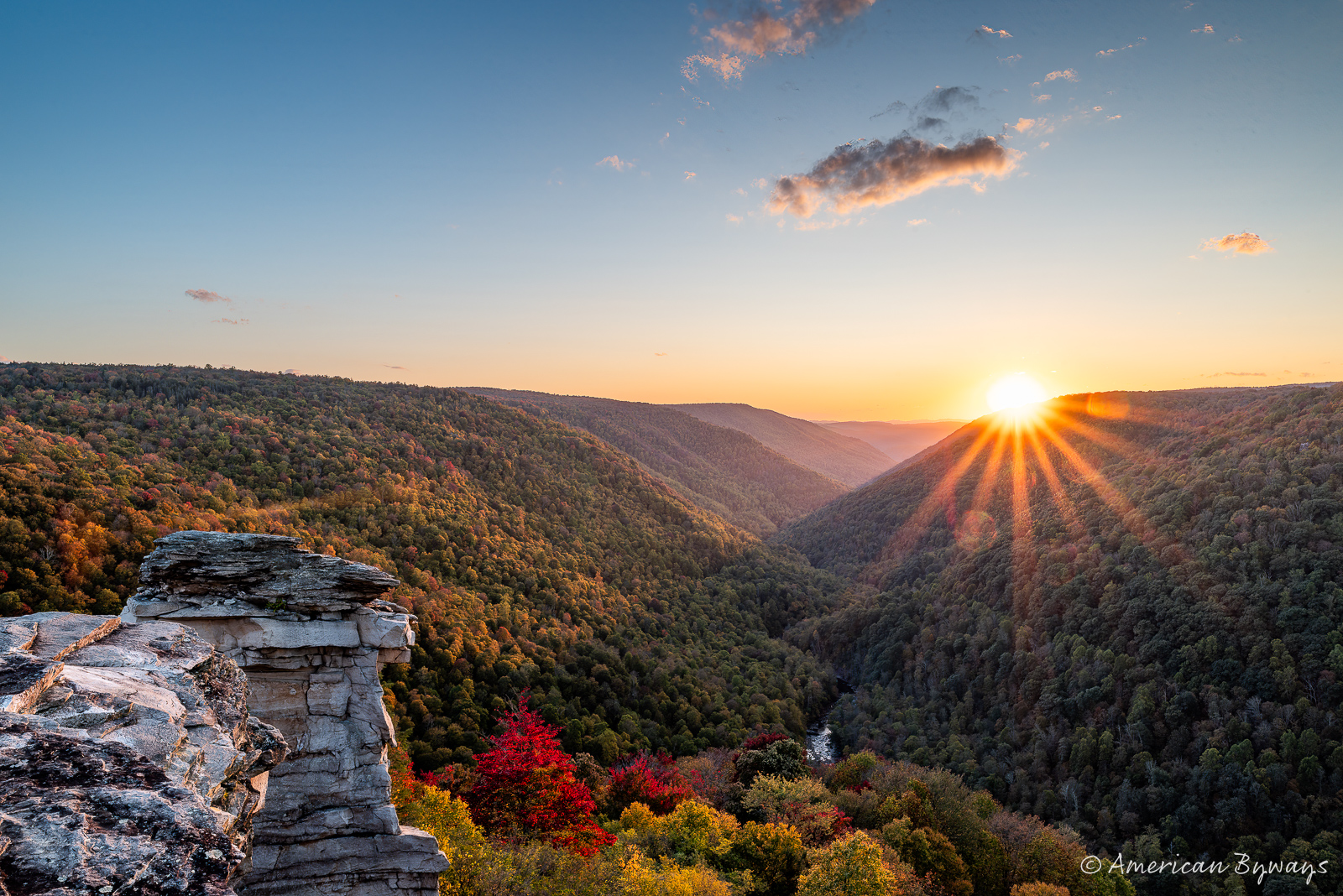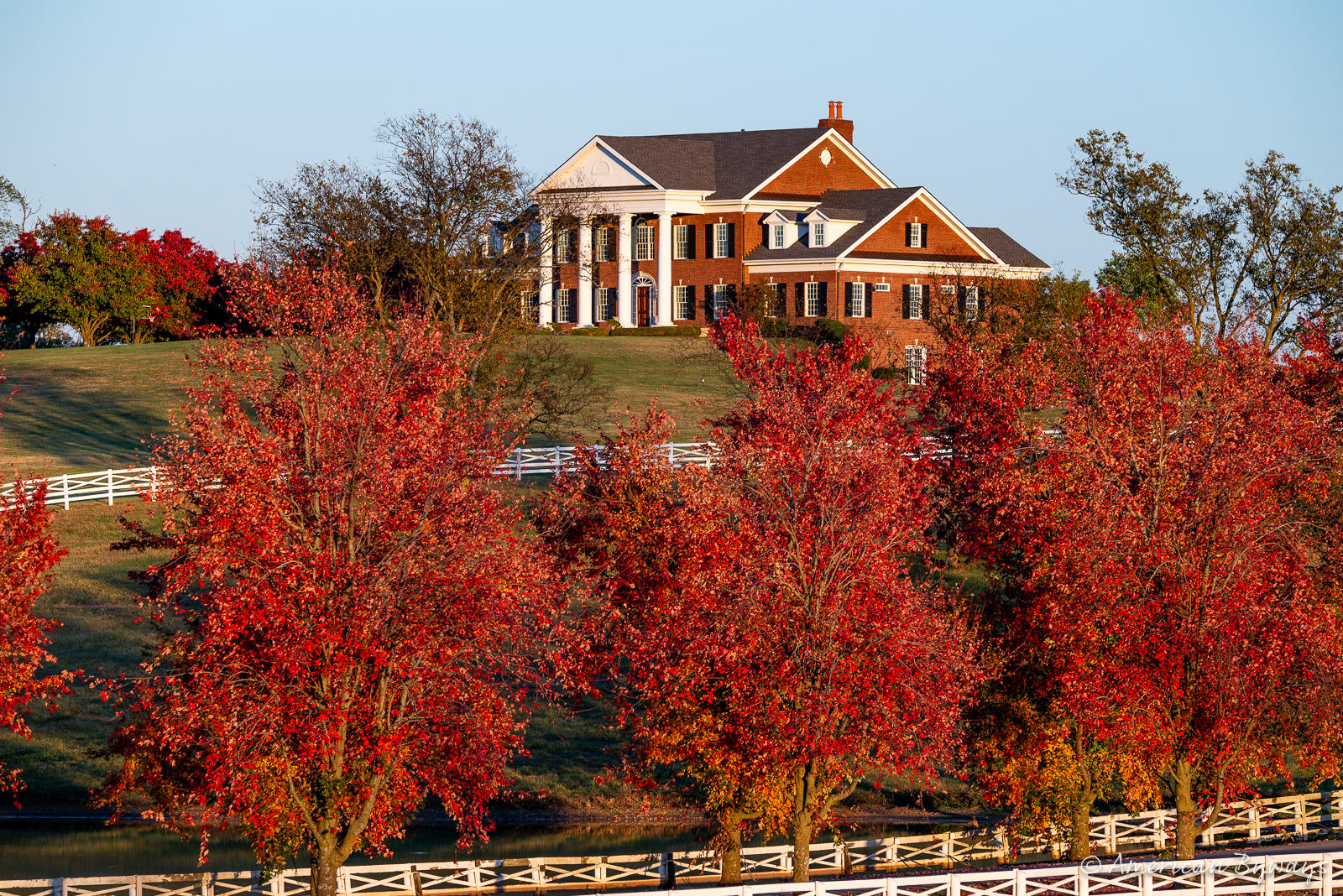
Leaf-Peeping Along Two of Kentucky’s Famed Scenic Byways
On a balmy autumn afternoon, Adam Paris, a fellow photographer, and I set out to explore the captivating heart of Kentucky’s famed Bluegrass region. As we traversed the undulating hills and picturesque vistas of Fayette, Woodford, and Jessamine Counties, we were constantly enchanted by the lush green horse pastures and the region’s unmistakable Southern charm. Each bend in the road introduced us to a new visual delight, showcasing the enduring beauty and idealistic allure of this rural paradise.
Set against the verdant backdrop of the Bluegrass region, our adventure led us to the gates of the time-honored Manchester Farm. Concealed in the shadows of the esteemed Keeneland Race Track, this farm isn’t just land and buildings; it’s an embodiment of history, as timeless and profound as Lexington’s storied past.
Journeying back to 1782, the vast expanse of Manchester Springs Farm stretched over an impressive 1,400 acres. The founder of Lexington, Col. Robert Patterson, recognized Manchester Creek in the 1770s as an esteemed locale for observing buffalo. In the early 19th century, specifically 1804, Francis Keen, the patriarch of the Keene lineage, bequeathed 200 acres of this prized land to his offspring. The property remained within the family folds for five successive generations. However, in 1935, a pivotal shift occurred when J.O. “Jack” Keene sold a significant 147-acre parcel to the Keeneland Association, marking the inception of an exemplary race track.
Fast forward to 1976, and the narrative introduces Mike G. Rutherford, a Texan deeply enamored by this Bluegrass jewel. He acquired Manchester Farm from the accomplished horseman, Duval Headley, a scion of the Hal Price Headley lineage, instrumental in the inception of Keeneland.
During my academic tenure at the University of Kentucky, I was fortunate enough to frame an emblematic Kentucky tableau: Manchester Farm’s majestic horse barn, guarded by ash and maple sentinels, set against flourishing fields, all bordered by the signature white three-rail horse fencing. This picturesque image serves as a poignant tribute to Manchester Farm’s enduring allure and legacy.
Yet, upon my recent visit, a disconcerting change was evident. The iconic horse fencing had vanished, the once-lush pastures nourished by calcium-rich waters had given way to fading soybean fields, and the edifices, including the historic Gray Mansion, stood eerily forsaken. Ownership of the farm transitioned to Brad Kelley in 2016 and later to Keeneland in 2022. While the racetrack’s management aspires to conserve the farm’s erstwhile equestrian grandeur, the Gray Mansion, with its cinematic past featuring in classics like “Gone with the Wind” and “Kentucky,” languishes in neglect.
Traveling westward along the picturesque Old Frankfort Pike, a National Scenic Byway, we paused to soak in the autumnal beauty of the surroundings, with the New Union Christian Church in Woodford County serving as the backdrop. The vibrant hues of the changing leaves set amongst the brick church building created a colorful canvas.
The New Union Christian Church has a storied past dating back to 1834. Its inception was sparked by a faction of Baptists from Mt. Vernon Baptist Church. Their quest to hear an itinerant evangelist, championing the principles emerging from the Stone-Campbell movement, led them to separate from their original congregation. This movement, rooted in the transformative Cane Ridge revivals of 1800 and influenced by Enlightenment philosophies introduced to American shores, championed the ideals of Christian unity.
By 1839, this devoted group had built a modest brick meeting house near the tranquil Elkhorn Creek. Its straightforward design mirrored its humble beginnings. In the subsequent years, the church flourished, at one point boasting a congregation of over 90 adults. Around the mid-19th century, a segment of its members, along with their pastor Dr. L.L. Pinkerton, branched out to establish the Midway Christian Church.
The initial meeting house endured until 1960 when structural evaluations deemed it unsafe for a roof replacement. Rather than witnessing its inevitable collapse, a few devoted members took it upon themselves to dismantle the beloved structure. Despite its lack of modern amenities, the sentiment attached to it was profound. In an ode to its legacy, bricks from the old building and its original pews were incorporated into a new edifice, erected on the same ground in 1963. This new sanctuary, inaugurated with hope and reverence, boasted several modern upgrades, including a basement with functional spaces, a nursery, adaptive classrooms, two restrooms, and an expansive entrance.
Architectural nuances of the church, like the faintly tinted windows in pastel shades of yellow, pink, and blue, echo the charm of yesteryears. The two round windows at the building’s front are particularly evocative. They feature 12 outer panes symbolizing the disciples and four inner panes representing the Gospels, with the central frame forming a cross. Yet, apart from these few symbolic elements and a brass cross gracing the communion table, the church remains devoid of overt religious symbols. This minimalism speaks to the congregation’s belief in a direct, unmediated connection with the sacred.
We then turned our attention to Pisgah Pike. This serpentine two-lane road elegantly weaves its way amid tranquil family-owned farms and holds the distinction of running through the most expansive rural historic district in the Commonwealth.
Tracing back to 1780, this region is steeped in history. Samuel Stevenson and Jane Gay, seeking a life beyond the protective confines of the fort at Lexington, established their home in a log cabin close to what would later be known as Mount Pisgah. Not far behind were pioneers like Alexander Dunlap and his wife, Agnes Gay, followed by John Gay with Sally Lockridge, and Moses Mollvanin alongside Margaret Hodge. These early settlers, bound by proximity and faith, established their dwellings within a stone’s throw of the springs and each other. Their shared Presbyterian beliefs became the cornerstone of this burgeoning community, drawing in like-minded families.
In the nascent stages, religious services found humble abodes in the homes of these settlers. Recognizing the need for a dedicated place of worship, Samuel Stevenson and his wife graciously allocated two acres of their land atop a neighboring hill for the construction of a church and its adjoining graveyard. The first church, built from logs, stands testament to the collaborative spirit of these settlers, with Stephenson, Dunlap, Gy, Wason, and Mollvanin pooling in their efforts. In 1812, a stone edifice replaced the log structure a little higher up on the hill. By 1868, this church underwent a transformation, adopting the refined aesthetics of Gothic Revival architecture. Yet, its authenticity remained untouched, preserving the original stones and flooring. Later, in a touching tribute, Dr. Robert James adorned the church with stained glass windows, a poignant homage to his late mother.
Nearby, The Kentucky Castle seems almost misplaced amidst the region’s pastoral landscapes. This architectural oddity brings a touch of medieval Europe to the heart of the Bluegrass.
Its story began in 1969 when Rex and Caroline Bogaert Martin embarked on the ambitious task of building their dream home. Inspired by their European travels, they sought to recreate the splendor of a classic medieval castle. However, life had other plans, and the original construction stalled, leaving the castle incomplete for years. It wasn’t until 2017 that the castle experienced a renaissance. Under new ownership, it underwent extensive renovations and was transformed into an exquisite boutique hotel, event space, and fine dining venue.
Today, The Kentucky Castle stands as a testament to timeless elegance and ambition. Its turrets and stone walls, which once whispered of a bygone age, now resonate those who are drawn to its unique blend of narrative and extravagance.
Our explorative sojourn through the heart of Kentucky culminated in Jessamine County, where we found ourselves at the venerable Keene Springs Hotel. This sprawling, two-story edifice constructed of wood frames and inspired by Greek Revival architecture, was built in sections starting in 1841. Its creator, Mason Singleton Jr., chose the quaint hamlet of Keene as its home.
Singleton, alongside his wife Nancy, envisioned the establishment as a luxurious resort, capitalizing on the healing allure of the nearby white sulfur springs. The couple dedicated themselves to the operation of both the hotel and tavern, fostering a welcoming destination for visitors until 1857, at which point they passed the reins to Alfred McTyre. However, the post-Civil War era brought with it economic challenges, resulting in a significant decline in tourist travel. In 1868, F.S. Wilson acquired the hotel, transforming it into a boarding house, a role it maintained steadfastly through the twilight of the 19th century. The 20th century witnessed a shift, as descendants of the Wilson family repurposed the structure, alternating between a general store named Wilson’s and a private residence, until the 1960s.
In its later years, the historic Keene Springs Hotel embraced a new identity, housing a home-style dinner restaurant.
Amidst the autumnal amber that adorned Kentucky’s Bluegrass region, Adam and I ventured through its enchanting byways, seeking the historic churches and undulating meadows that define its essence. Our journey unveiled the profound symphony of history and nature that echoed the region’s eternal allure.






















